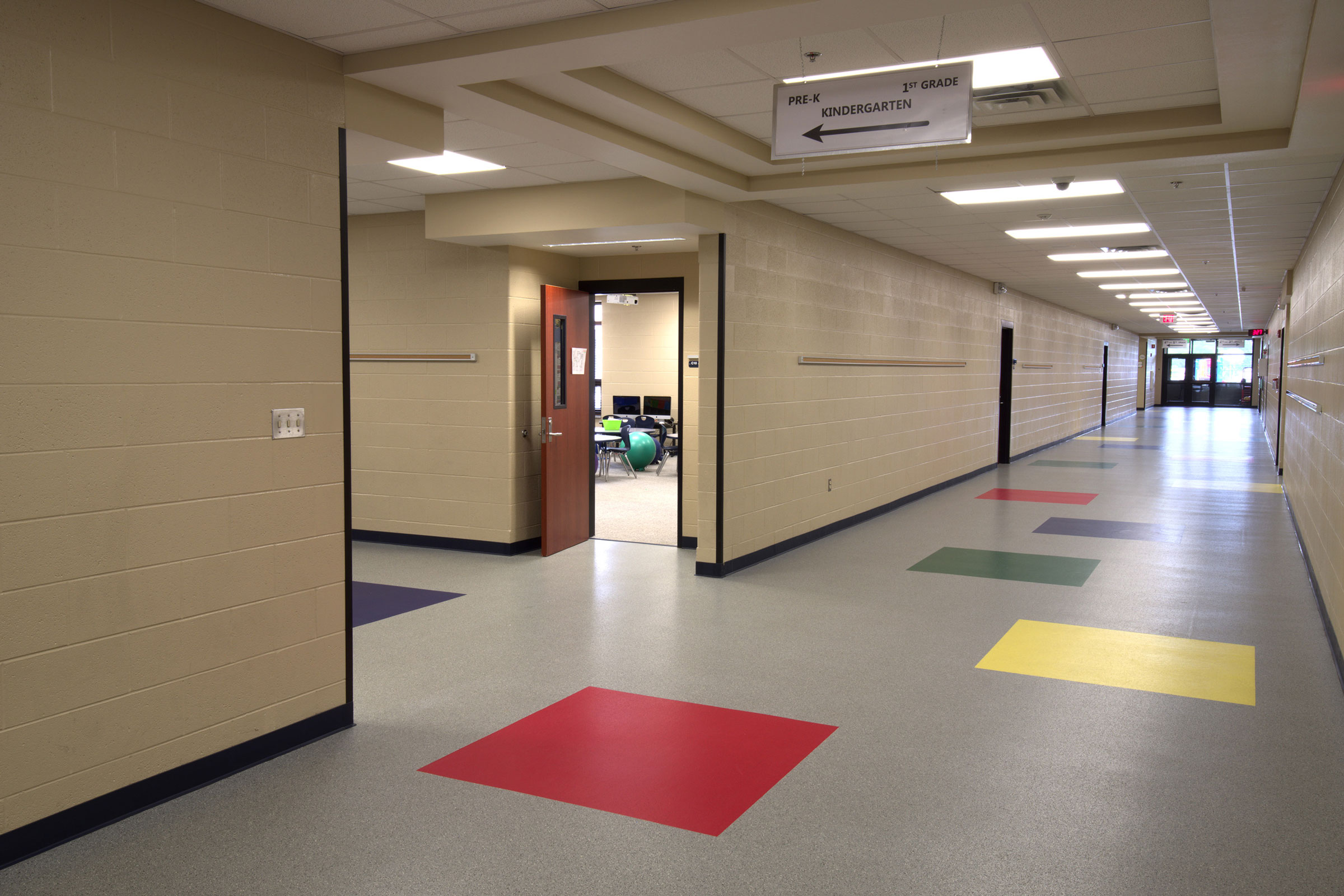Story at a glance:
- Today most rubber floors make use of recycled rubber, which makes them a highly sustainable flooring option.
- Benefits of rubber floors include extreme durability, comfort, shock absorption, noise reduction, and a high chemical resistance.
- Rubber floors come in a variety of forms—including mats, tiles, interlocking panels, and rolls.
Rubber has long been used to create a variety of products—including flooring. Traditionally rubber floors were made using the sap from para rubber trees—it was this natural rubber that allowed Charles Goodyear to create a rubber floor varnish in 1853.
In 1894 the first interlocking rubber tiles were patented by Frank Furness; Goodyear would introduce the first continuous sheet rubber flooring in the 1920s. High demand and material shortages eventually led to invention of synthetic man-made rubber, which has been used since the 1930s.
Today most rubber floors incorporate some amount of recycled rubber—natural or synthetic—into their construction, making them a relatively sustainable flooring option.
Benefits of Rubber Flooring
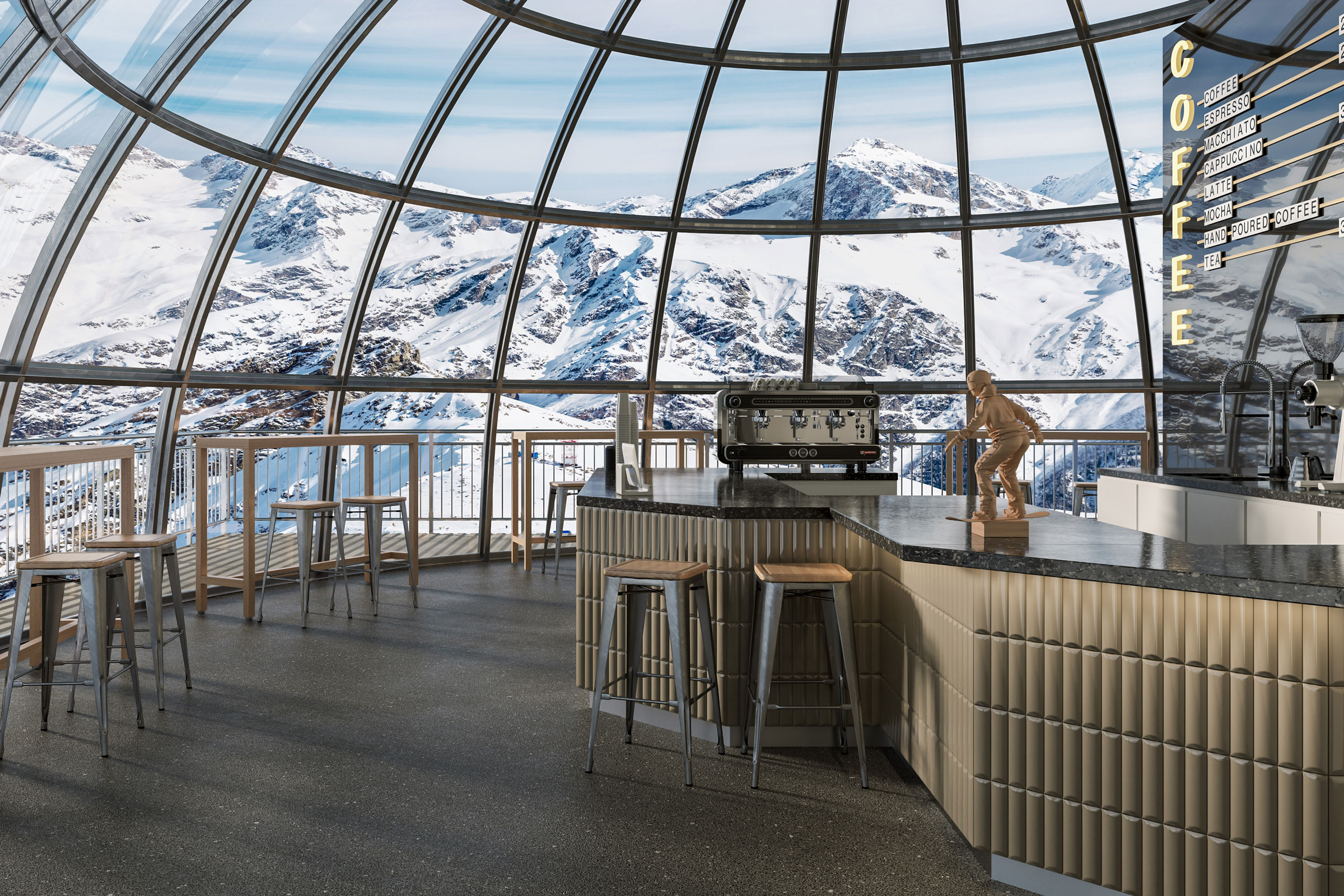
Rubber flooring makes this beautiful gastropub even more comfortable. Photo courtesy of REGUPOL
Rubber flooring has remained a popular flooring option for decades. Rubber offers a wide range of benefits that make it a desirable choice for gyms, schools, stadiums, health care facilities, and more.
Durable and Long-Lasting
Rubber flooring has a naturally high tensile strength thanks to its chemical composition, which makes it extremely durable and resistant to tearing or excess wear from exposure to the elements. Rubber floors can be strengthened further through the process of vulcanization, which uses extreme heat and sulfur to create new cross-linked chemical bonds. This hardens the elastomers found in rubber, making it more resistant to chemical breakdown.
On average properly installed (and maintained) rubber flooring lasts for upwards of 20 years. And once rubber flooring reaches the end of its operational life cycle it can be recycled for further use.
Environmentally Friendly
Natural rubber is derived from plant matter and eventually decomposes over time, making it a more environmentally friendly option than, say, plastic. Historically, however, the harvesting and production of rubber—particularly for use in tires—has contributed to deforestation and pollution.
Fortunately rubber can be reused once it’s reached the end of its operational life cycle, and many rubber flooring manufacturers incorporate tires and other recycled rubber waste in their products.
REGUPOL, for example, is one of the leading manufacturers of rubber flooring products and an industry innovator in the reuse of post-consumer tires. “The company’s products use 93% to 96% post-consumer waste, diverting that from landfills to recycle 99M tons of elastomers per year and helping to support the ecological health of our planet and the water table,” Wil Younger, marketing manager for REGUPOL, previously wrote for gb&dPRO.
Shock Absorption
Rubber flooring’s elastic and viscous properties also make it an excellent shock absorber, one that is capable of withstanding heavy impacts and vibrations without sustaining damage. It is for this reason that rubber flooring is often used in gyms, as rubber can handle frequent impacts—such as dropping weights or barbells—much better than concrete or wood, both of which are liable to split, crack, or chip when subjected to high-force impacts.
Slip-Resistant
Due to its high coefficient of friction, rubber flooring is naturally slip-resistant—a quality that can significantly reduce the likelihood of workplace, gym, and school accidents. Even if rubber flooring gets wet, it still maintains a high level of friction—especially when compared to ceramic/porcelain tile, linoleum, and vinyl flooring.
If desired, rubber flooring can be made even more slip-resistant by adding textured surfaces or drain holes, the latter of which helps keep water from pooling in the first place.
Noise Reduction
Similar to how it absorbs shockwaves, rubber flooring also absorbs sound. When used as flooring, rubber acts as a natural acoustic dampener and can help reduce noise transmission between floors. When paired with rubber wall panels and/or rubber ceiling treatments, rubber floors significantly aid in sound control, making them ideal for use in gyms and schools.
“High-noise levels hinder teaching and learning in schools and negatively impact productivity in offices,” Younger said. “With flooring, one of the most abundant finishes in the built environment, the opportunity to positively influence the acoustical performance of a space is great.”
REGUPOL‘s Revolution line of commercial rubber floors, for example, are known for their sound-absorbing qualities and have been installed in academic institutions like the Arbor Grove Elementary School in Oklahoma City.
Versatility
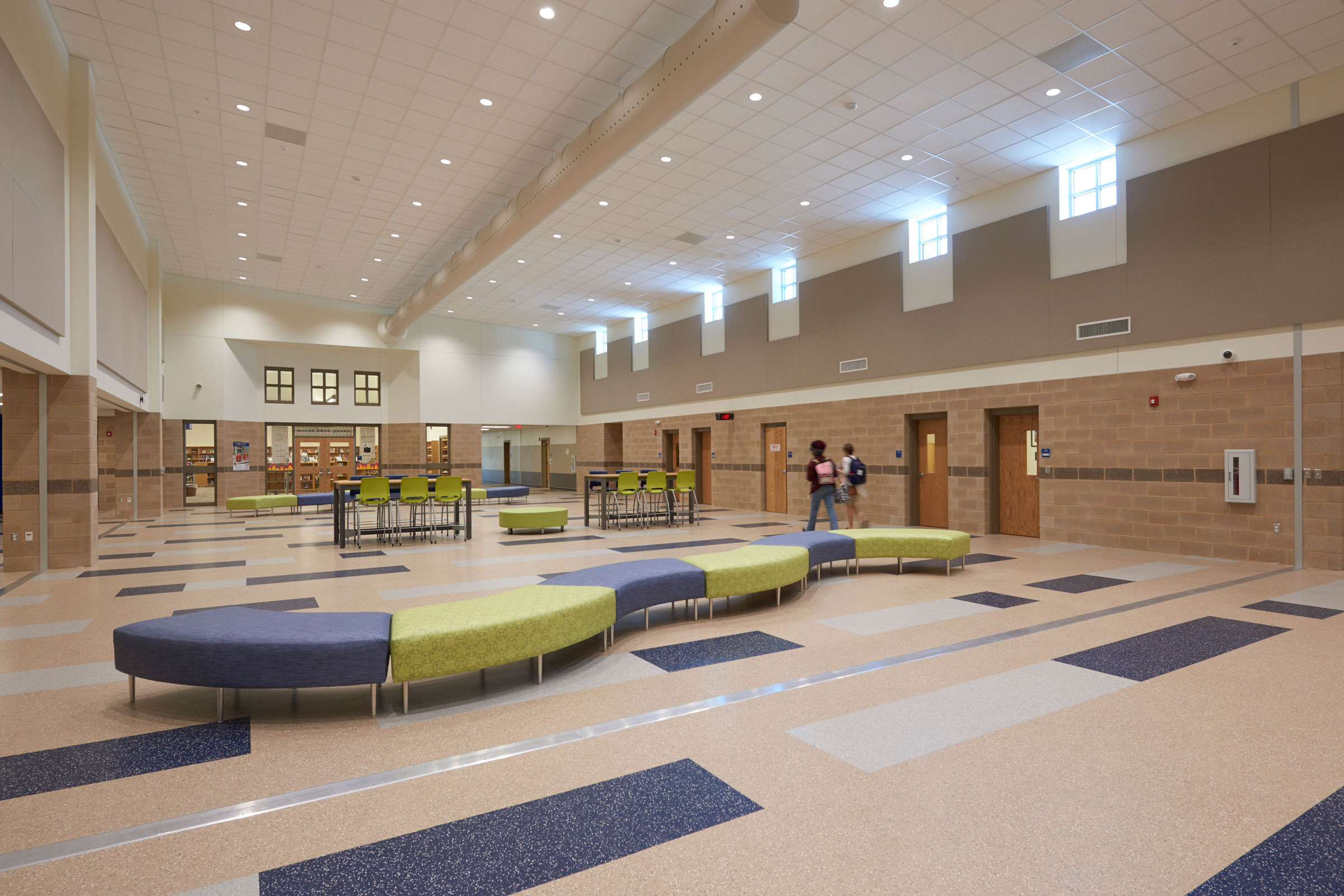
The design of rubber flooring has evolved greatly over the years to be a great fit for educational spaces. The Pearson Ranch Middle School in Austin features Roppe flooring, shown here. Photo courtesy of Roppe
Another benefit of rubber flooring is its versatility. Rubber floors come in a variety of colors, shapes, and designs, making them suitable for use in almost any setting you can think of—from schools to industrial facilities, rubber flooring can meet the practical and aesthetic needs of a diverse array of institutions.
Comfortable Underfoot
While still firm, the natural elasticity of rubber flooring makes it significantly more comfortable underfoot compared to concrete, tile, or even wood flooring. This can help reduce the likelihood of developing back, foot, and knee pain for employees who must stand for long periods of time or for those lifting heavy weights in, say, a gym setting.
Low Maintenance
Once rubber floors are installed, they are very easy to take care of. When installed in residential settings, rubber flooring only needs to be vacuumed once a week and mopped every so often.
Of course, maintenance increases somewhat for rubber floors installed in gyms, labs, commercial centers, and any other facilities that receive frequent foot traffic—in these instances, rubber floors may need to be vacuumed or mopped daily or several times a week.
Hypoallergenic
Aside from containing latex, rubber flooring is naturally hypoallergenic and therefore unlikely to cause allergic reactions in those who come into contact with it. Rubber flooring also possesses some antimicrobial properties (of which can be made stronger through the addition of certain compounds), making it resistant to mold and mildew growth, both of which can cause respiratory illnesses and allergy-like symptoms.
Chemical Resistance
Lastly, the non-porous nature and molecular composition of rubber flooring offers an admirable layer of chemical resistance. Instead of penetrating the floor’s surface and breaking the material down, chemicals, acids, and grease typically sit on the surface of a rubber floor without causing excessive damage or staining.
This makes rubber flooring ideal for installation in laboratories and manufacturing plants that regularly handle strong chemicals.
Types of Rubber Flooring
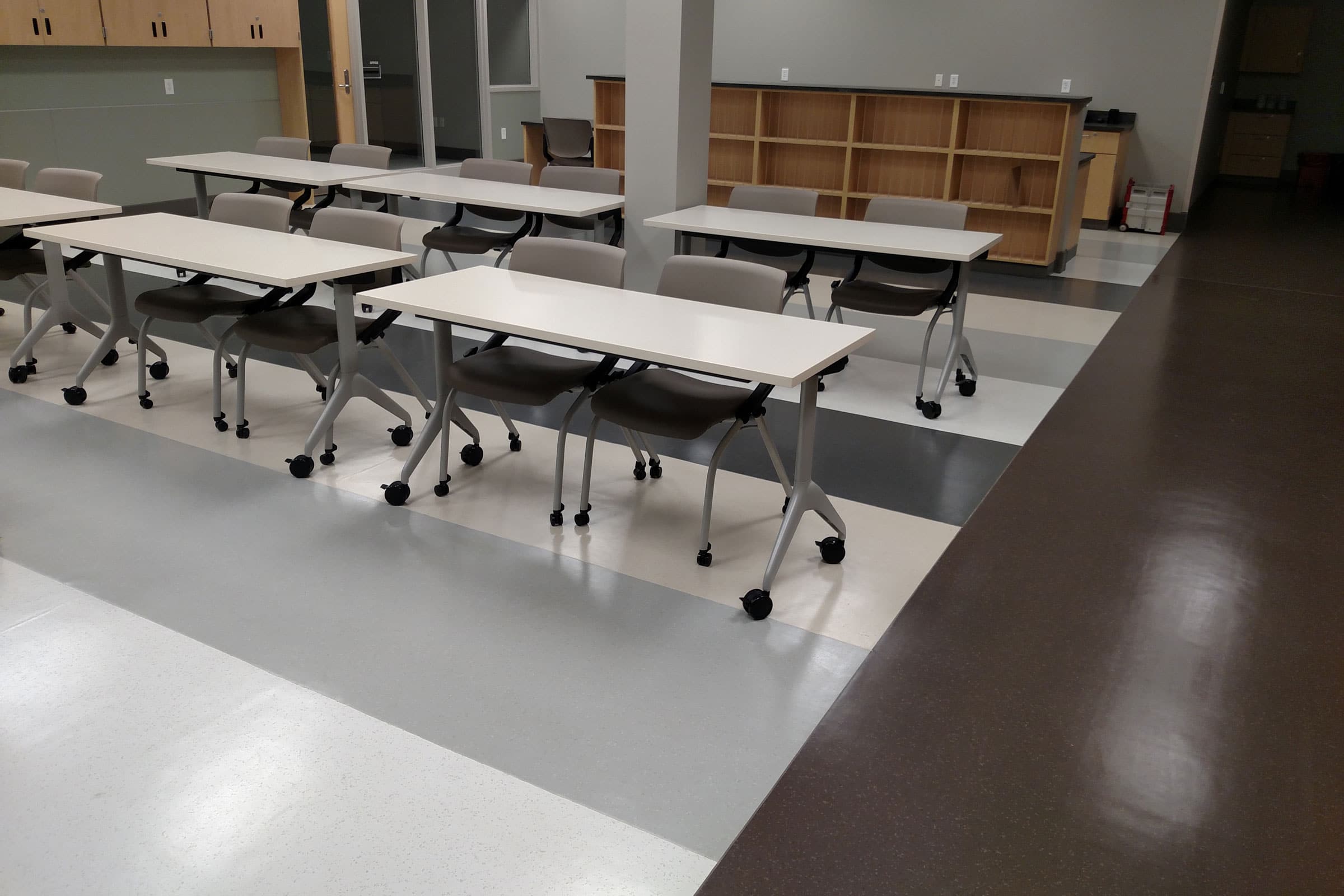
Roppe Rubber Tile and Tread offer ease of maintenance as seen here at the Fostoria Learning Center. Photo courtesy of Roppe
As previously mentioned, rubber flooring is highly versatile and comes in a wide range of types, styles, and applications. This section provides a basic explanation for the most popular types of rubber flooring.
Rubber Tile Flooring
As probably the most popular type of rubber flooring, rubber tiles typically take the form of large squares or rectangles. These tiles come in a range of sizes and thicknesses and may be used as is or cut to size to create a near-seamless flat surface.
Rubber tiles are most commonly used in commercial and residential settings.
Rubber Roll Flooring
Rubber roll flooring is similar to rubber tile and sheet flooring but creates fewer seams, as rolls typically range anywhere from 20 to 50 feet long. Rubber rolls are ideal for covering large areas—such as industrial spaces, workout facilities, stadiums, and the like—and are often the most economical rubber flooring option.
Due to their size, however, rubber rolls can be slightly difficult to install and replace.
Rubber Interlocking Flooring
Technically speaking, interlocking rubber floors are a type of rubber tile flooring that utilize interlocking edges to join individual tiles together. Rubber interlocking floors are one of the easiest types of rubber flooring to install and may be fitted together like puzzle-pieces to cover large areas.
Once installed, interlocking rubber forms offer a relatively seamless appearance and may be sealed around the edges if desired.
Rubber Playground Flooring
As the name implies, rubber playground flooring is a type of rubber floor specifically designed for playground use. Most rubber playground floors utilize recycled rubber, which typically has a higher UV tolerance and slip-resistance than fresh rubber.
Rubber playground floors can either be poured in place or they may make use of rubber tiles, rolls, and the like.
Athletic Rubber Flooring
Typically used in gyms and sports facilities, athletic rubber flooring comes in the form of tiles or rolls and offers adequate shock-absorption to account for frequent impacts.
Due to rubber’s elasticity, athletic rubber floors are less likely to cause serious injury should an athlete or gym-patron fall.
Rubber Industrial Flooring
Due to high traffic and exposure to potentially corrosive chemical compounds, rubber floors designed for use in industrial settings are typically made from vulcanized synthetic rubber, which is stronger and offers more chemical resistance than virgin rubber.
Industrial rubber flooring is also often textured, as this provides better traction and reduces the risk of workplace accidents.
Rubber Stair Treads
Commonly seen in schools and stadiums, rubber stair treads are exactly what they sound like—textured rubber treads designed to be installed on stairs. Due to both the textured surface and rubber’s natural anti-slip properties, rubber stair treads are an excellent safety feature that reduce the risk of falling or tripping while walking up or down stairs.
Rubber Matting
Generally speaking rubber mats are used independently of one another as opposed to being used to cover an entire floor. Rubber mats can be laid out on any type of flooring to provide an extra layer of protection and cushioning. Mats are ideal in places that do not require the entire floor to be capable of absorbing impacts, like home gyms.
Common Applications of Rubber Flooring
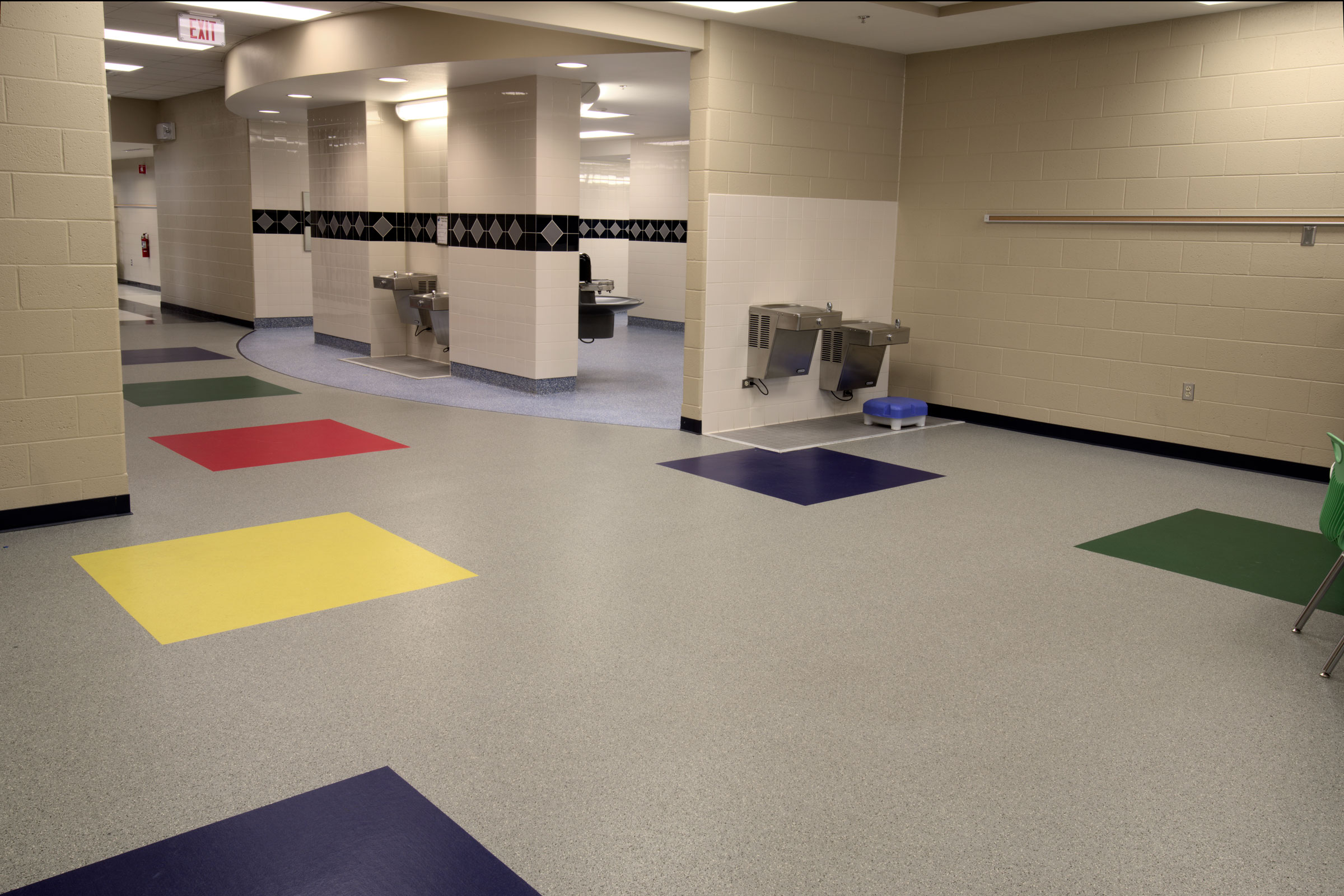
Rubber flooring installed in the Arbor Grove Elementary School. Photo courtesy of REGUPOL
Most people associate rubber floors with gyms and stadiums—and while these are two places you’ll often find rubber floors, they are by no means the only applicable locations.
There are very few places where rubber flooring can’t be applied.
“There are very few places where rubber flooring can’t be applied, and it is often specified for environments like commercial kitchens, waiting rooms, and even medical labs,” Bill Neifert, commercial division sales director for North America at REGUPOL, previously wrote for gb&dPRO.
Rubber flooring is very versatile and may be installed in a wide range of facilities, including:
- Gyms and Fitness Centers
- Playgrounds and Recreational Areas
- Schools and Educational Facilities
- Health Care Facilities
- Commercial Buildings
- Sports Facilities and Stadiums
- Industrial and Warehouse Spaces
- Residential Spaces
- Hospitality and Recreation Facilities
- Laboratories and Cleanrooms
Foam vs Rubber Flooring
Foam and rubber floors both provide comfort, shock absorption, waterproofing, and easy maintenance. But despite sharing some similarities with rubber flooring, foam flooring falls short in a few important ways, with the most glaring being durability.
Unlike rubber, foam flooring is prone to indentation under extremely heavy weights and is easier to puncture or scratch, making it a poor choice for use in gyms and workout facilities. In general foam flooring is only meant for activities like stretching, bodyweight exercises, and yoga.
Foam flooring also has a much shorter operational lifespan than rubber; you can expect to replace foam floor panels within just five to 10 years. Of course, rubber flooring is more expensive and considerably heavier than foam flooring—but that’s because it’s durable and of a higher quality.
Carpet vs Rubber Floor Mats
Similarly, carpet is commonly used as an alternative or substitute for rubber floor mats, especially in vehicles. At first glance they may seem fairly comparable. Rubber floor mats and carpet are both soft underfoot, offer some measure of noise reduction, and are easy to install.
Carpets do not, however, offer the same durability as rubber floor mats. They’re highly susceptible to staining, are easily damaged by water, harbor dust and other allergens, and typically require replacing after just five to15 years.
You may not have as many aesthetic options when it comes to rubber floor mats, but they offer a much higher level of protection than carpet and are more economical in the long run.
How to Install Rubber Floors
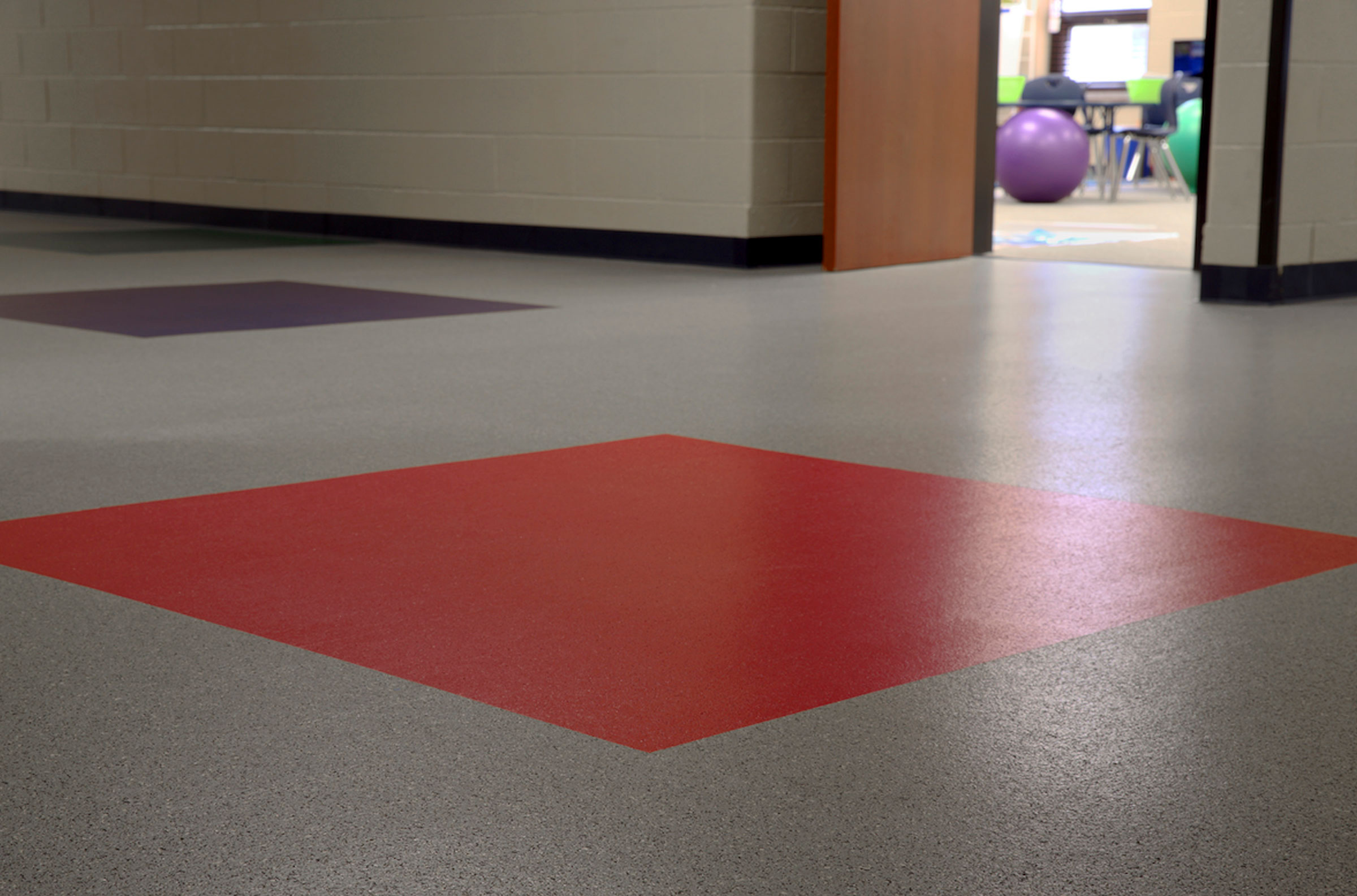
Photo courtesy of REGUPOL
Regardless of whether you’re installing rubber flooring yourself or if you’re leaving it to a team of professionals, it’s a good idea to familiarize yourself with the methodology. And while the exact installation process will ultimately depend on the type of rubber flooring you choose, the procedure typically follows these basic steps:
Prepare the Subfloor
Before rubber flooring can be installed, the subfloor needs to be prepared. This step consists of cleaning the subfloor’s surface and ensuring that there isn’t any dirt or dust that could impede the rubber from adhering properly.
You will also need to make sure that the subfloor is dry and free of moisture before installation.
Acclimate the Rubber Flooring
Once the subfloor has been prepped, the rubber flooring needs to be acclimated. In this context acclimation entails removing the rubber flooring from its packaging and laying it out for a period of at least 24 hours. This gives the rubber sufficient time to acclimate to the room’s ambient temperature.
Measure and Plan
After the rubber has acclimated, you’ll want to lay out the flooring so that you can measure and plan appropriately. Unless you get really, really lucky, chances are you’ll need to trim the edges of some of your rubber panels or rolls to ensure they fit snug against one another without any gaps.
Take your time and measure carefully to avoid having to make impromptu adjustments or wasting material.
Trim and Fit
Once you’ve measured the rubber flooring—and measured it again—use a straight edge and utility knife to trim off any excess. Fit the trimmed panels in place to ensure they are snug, make adjustments if necessary, and remove the panels.
Apply Adhesive
Now that you’ve trimmed the flooring, you’re ready to start applying adhesive. If you’re installing rubber panels, you’ll want to put down a light layer of adhesive on the floor underneath each panel, applying as you go to ensure the adhesive doesn’t start to dry out. If you’re installing rubber rolls, it’s generally recommended that you apply a 10-foot long layer of adhesive at a time.
Install & Tamp Down the Rubber Flooring
Once you’ve applied adhesive to the area, start installing the rubber flooring. Take care to ensure each panel or roll is laid out flat and is aligned properly to avoid unseemly gaps. After you’ve laid out all of your rubber flooring, use a heavy roller or tamper to make sure that the rubber adheres properly to the subfloor.
Allow for Curing
After the flooring has been installed and tamped down, you’ll need to allow time for the adhesive to cure. Curing times can vary depending on the type of adhesive you use, so always check the product instructions. In most cases, however, rubber flooring takes 24 to 48 hours to sufficiently cure, at which point it may be subjected to the facility’s normal foot-traffic levels.
Install Transition Strips (if needed)
Once your rubber flooring has cured, install transition strips if necessary. Transition strips are thin strips (often made from either rubber, metal, wood, or plastic) used to join floors of differing materials together. They essentially serve to fill gaps caused by different thicknesses and help account for the expansion and contraction of materials.
Rubber Floor Maintenance
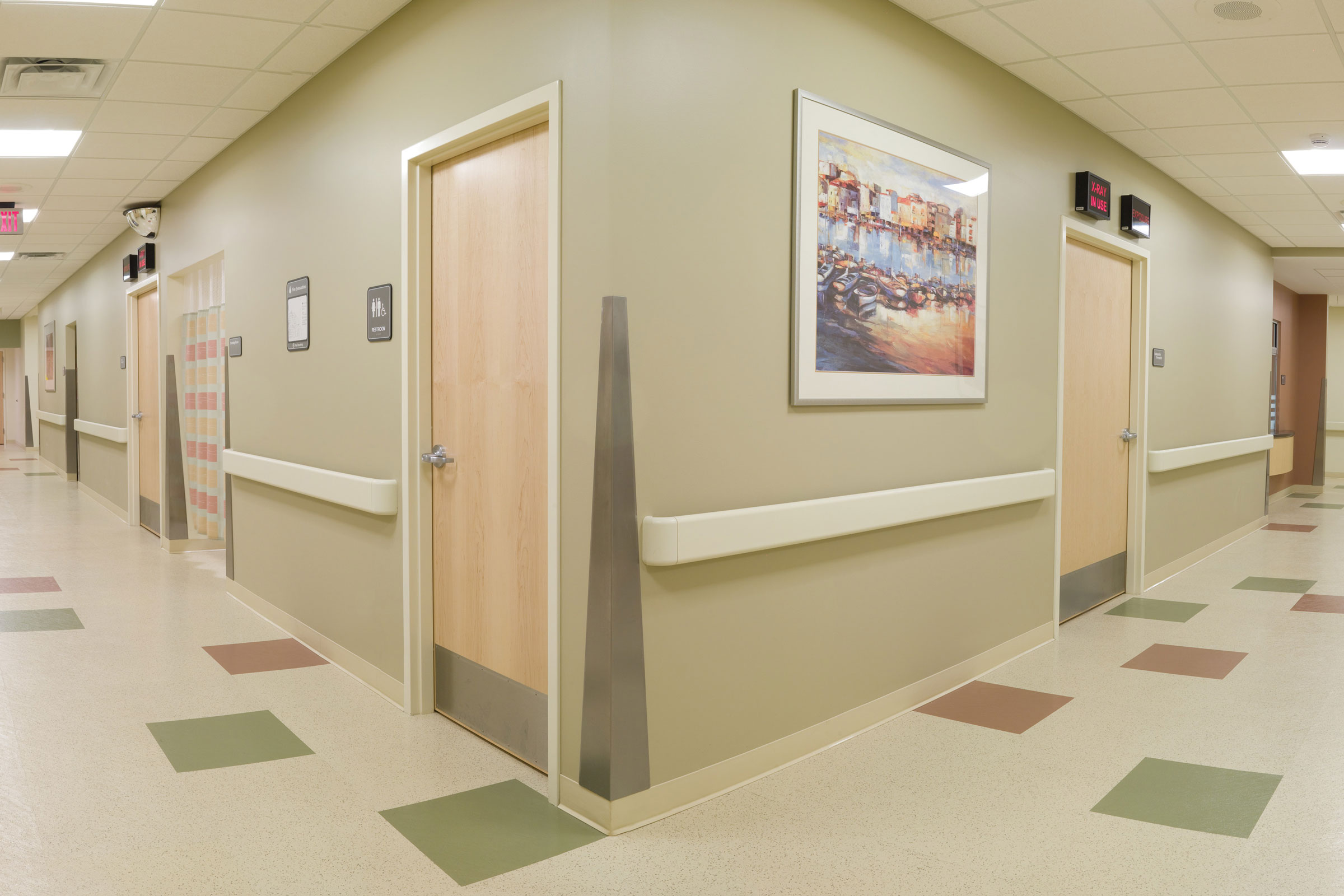
Rubber flooring continues to be popular in health care spaces, too, because of its durability and ease of cleaning. Photo courtesy of Roppe
Once installed rubber flooring is fairly low maintenance and relatively easy to take care of. There are, however, a few routine practices one should adhere to in order to keep rubber flooring in good condition, including:
Regular Cleaning
As is the case for any type of flooring, rubber floors should be cleaned with some measure of regularity. The frequency and intensity of cleaning will largely depend on the conditions the floor is regularly subjected to and the cleanliness standards of the facility itself. In most cases, however, rubber flooring only needs to be vacuumed and/or lightly mopped once or twice a week.
Promptly Address Spills
In order to avoid undue staining or damage, anything spilled on rubber floors—whether it’s as mundane as juice or something stronger, like chemicals—should be cleaned up as soon as possible. In most instances, a sponge or mop with soap and water is enough to sufficiently address spills on rubber floors.
Periodic Deep Cleaning
To avoid having layers of grime or dirt build-up on the floor’s surface, rubber flooring should receive periodic deep cleaning. It is typically recommended that you use either a walk-behind or ride-on scrubber filled with water and a basic or neutral pH cleaner to wash your facility’s rubber floors. Un-textured rubber floors should be cleaned with a light floor cleaning brush, whereas textured floors may require a brush with two different bristle lengths.
Avoid Excessive Moisture
Despite being fairly resistant to water damage, rubber floors still shouldn’t be exposed to excessive moisture, as water can seep underneath the rubber and compromise either the adhesive holding it in place, the backing material, or the subfloor itself.
Protect from Sunlight
Most rubber flooring manufactured for indoor use does not have a particularly high resistance to UV-rays, which means it can fade and weaken over time if regularly exposed to sunlight. To reduce the risk of UV damage, don’t install rubber flooring in areas that receive direct sunlight. If exposure to sunlight is inevitable, specify ahead of time that your rubber flooring needs to be made UV-resistant.
UV damage typically isn’t something you need to worry about if the rubber flooring you’re installing is designed for outdoor use, as these products generally contain additives to make them UV-stable.
Inspect for Damage
It’s generally a good idea to regularly inspect rubber floors for damage at least once or twice a month, depending on the type of traffic it receives. As long as damage is noticed early on, repairs can be made fairly easily—especially if you’ve installed rubber tiles or interlocking rubber panels, as these can easily be removed and replaced.
Cost of Rubber Flooring
There are many factors that can affect the cost of rubber flooring, but you can generally expect to pay between $1 and $15 per square foot for the materials and between $2 and $20 per square foot for installation.
Fortunately, rubber flooring can be relatively easy to install, especially if you’re installing rubber tiles on a smaller scale, such as in a home gym. If you decide to install your rubber flooring yourself, you’ll save a fair bit of money in the process.
How to Choose the Right Rubber Flooring
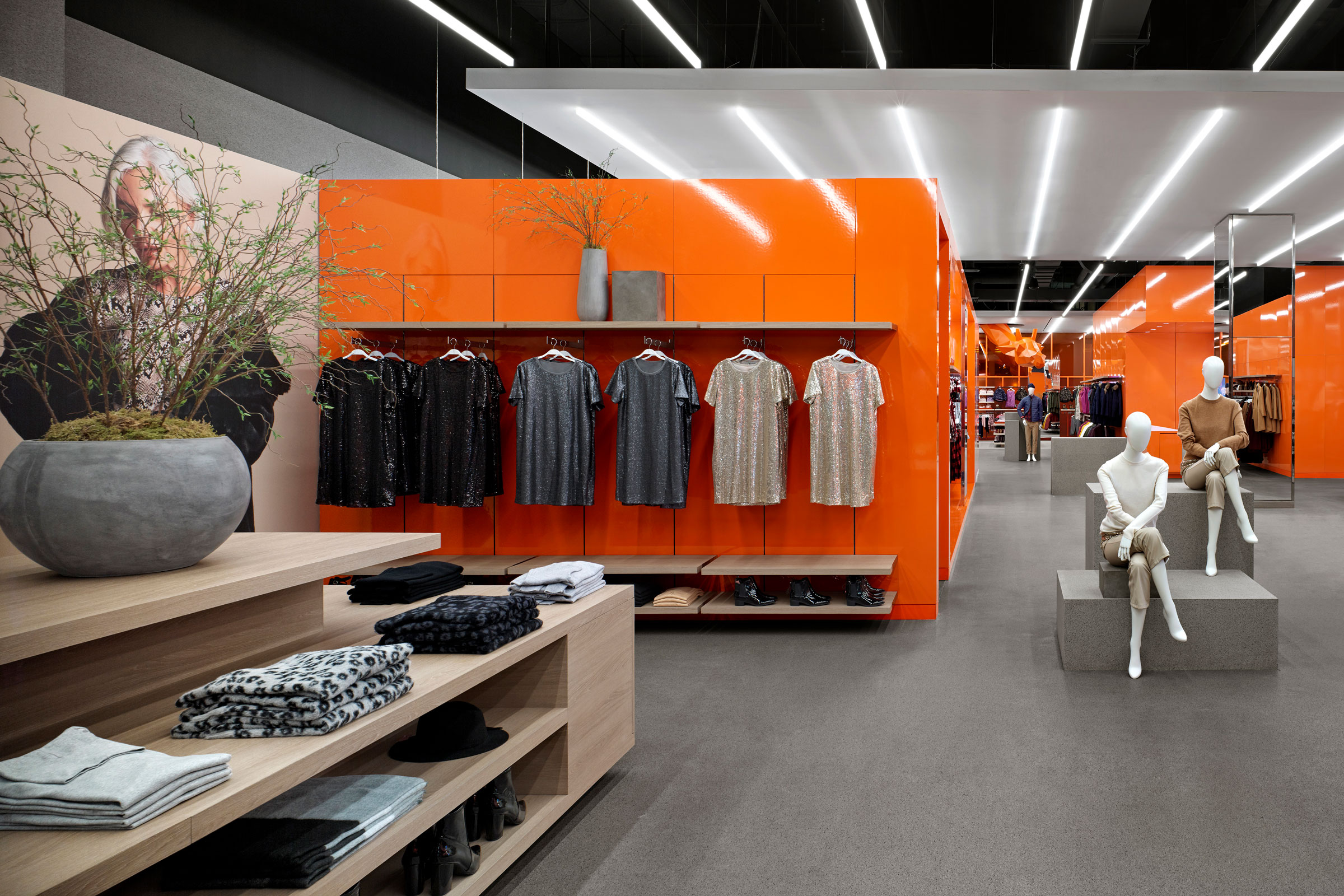
Rubber flooring inside Joe Fresh. Photo courtesy of REGUPOL
Once you know rubber flooring is what you want for your project, you’re ready to move onto choosing which type of rubber flooring will be the best fit.
Determine the purpose and intended use of the rubber flooring.
To ensure the rubber flooring you choose is right for the job, you’ll need to consider the floor’s purpose and setting. This can help determine whether you need rubber mats, tiles, or rolls and whether you need rubber flooring specifically designed for sport or industrial use.
Evaluate the durability of different options.
Even in its natural state, rubber is a durable material. That does not mean, however, that all rubber floors have the same durability. Thicker rubber tiles or rolls are denser and therefore offer better shock absorption than lightweight rubber options, whereas vulcanized rubber is stronger, has a higher chemical resistance, and wears slower than non-vulcanized rubber.
Assess safety features like slip resistance.
Rubber floors naturally offer some measure of slip resistance, even when wet, but additional anti-slip improvements can be added. Rubber floors with textured grips, ribs, or ridges, for example, offer better traction and can help reduce the likelihood of accidental falls.
Consider the maintenance requirements of the rubber flooring.
Regardless of the type of rubber floors you install, they’ll still require routine maintenance. As a general rule flat, untextured rubber floors are easier to clean than textured rubber floors. The latter can trap dirt and debris, which may require slightly more specialized tools to remove.
Evaluate comfort and ergonomic properties.
Generally speaking, all rubber floors are more comfortable and ergonomic than, say, wood, tile, or concrete floors, but not all rubber floors offer the same level of comfort. Textured rubber floors, for example, offer excellent traction and grip, but they aren’t as comfortable to walk or stand on for long periods of time.
Determine the desired aesthetic appearance.
While rubber floors are often colored black or gray, these are by no means your only color options. In fact, rubber floors can support a wide array of pigments without issue. Rubber floors also come in a variety of textures and patterns, such as two- or even three-toned speckling.
For this reason you’ll want to determine ahead of time what sort of aesthetic or design features your rubber flooring needs to adhere to, to avoid clashing with existing design choices.
Assess the environmental impact of the rubber flooring options.
If you’re going for LEED certification—or if you just want your flooring to be relatively sustainable—take care to consider the environmental impact of your rubber flooring options. In most cases you’ll want to go with a manufacturer who incorporates recycled rubber into their flooring products, utilizes renewable energy to produce their rubber flooring, or who sources/harvests their rubber ethically.
Companies like Roppe, for example, work to produce rubber flooring products with as little environmental impact as possible. ““We continue to strive for improved processes that result in a reduction of greenhouse gasses, energy intensity, and landfill waste while increasing our waste conversion into sellable products,” Dee Dee Brickner, marketing manager at Roppe, previously told gb&d.
Evaluate the budget and cost-effectiveness.
Rubber floors can vary considerably in price depending on size, thickness, color, and composition, so you’ll need to weigh your options within your project’s budget. If you need to cover a large area, for example, rubber flooring rolls will typically be more cost-effective than installing individual rubber tiles.
Request samples and read testimonials to gather insights.
When possible request samples of different rubber flooring options to gain a better idea of how it feels and looks in person. In addition to requesting samples, read reviews and testimonials of the products you’re considering. These can often provide invaluable insight into how a product stacks up once it’s been installed.
Seek expert advice from flooring professionals.
Similarly, you can’t go wrong with seeking advice from flooring experts if you’re at a loss for which type of rubber floor is right for your project. Flooring professionals will be able to provide a more nuanced breakdown of the differences between various rubber flooring options and their qualities.
Conclusion
Due to its durability and versatile application, rubber flooring remains an incredibly popular flooring option, one that can be found in a wide range of facilities. Available in an array of different sizes, shapes, thicknesses, colors, and compositions, rubber flooring can find a home in just about any modern architectural project.
As long as rubber flooring is properly maintained, it is an economical and sustainable flooring option that can last for well over 20 years without needing to be replaced. Companies like REGUPOL and Roppe provide cost-effective rubber flooring solutions that incorporate recycled tires into their composition—which can also go toward earning your project LEED points.

